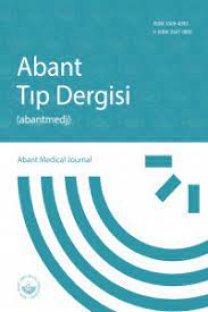Lomber omurga cerrahisinde revizyon cerrahisi nedenleri ve sonuçları: 72 ardışık hasta ile deneyim
Omurga, revizyon cerrahisi, komşu seviye disk hastalığı, nüks disk hernisi.
The causes and the results of revision surgery in lumbar spine: Experience with 72 consecutive cases
___
- 1. Wong C‐B, Chen W‐J, Chen L‐H, Niu C‐C, Lai P‐L. Clinical outcomes of revision lumbar spinal surgery: 124 patients with a minimum of two years follow‐up. Chang Gung Med J 2001;25:175‐82.
- 2. Cauchoix J, Ficat C, Girard B. Repeat surgery after disc excision. Spine 1978;3:256‐259.
- 3. Crock HV. Observation on the management of failed spinal operations. J Bone Joint Surg [Br] 1976;58:193‐199.
- 4. Stavridis SI, Bücking P, Schaeren S, Jeanneret B, Schnake KJ. Implant removal after posterior stabilization of the throcolumbar spine. Arch Orthop Trauma Surg. 2010; 130(1): 119‐123.
- 5. Hilibrand AS, Carlson GB, Palumbo MA, Jones PK, Bohlman HH. Radioculopathy and myelopathy at segments adjacent to the site of a previous anterior cervical arthrodesis. J Bone Joint Surg Am 1999; 81(4):519‐528.
- 6. Lehmann TR, Spratt KF, Tozzi JE, Weinstein JN, Reinarz SJ, el‐Khouryg GY, Colby H. Long‐ term follow‐up of lower lumbar fusion patients. Spine 1987; 12(2):97‐104.
- 7. Kaner T. Füzyon cerrahisinin dezavantajları, olası komplikasyonlar ve tedavisi. http://www.turknorosirurji.org.tr/TNDData/Bo oks/196/fuzyon‐cerrahisinin‐dezavantajlari‐ olasi‐komplikasyonlari‐ve‐tedavisi.pdf. 02.02.2015
- 8. Börcek AO, Suner HI, Emmez H, Kaymaz M, Aykol S, Paşaoğlu A. Accuracy of pedicle screw placement in thoracolumbar spine with conventional open technique. Turk Neurosurg 2014; 24(3): 398‐402.
- 9. Cinotti G, Gumina S, Giannicola G, Postachini F. Contrlateral recurrent lumbar disc herniation; results of discectomy compared with those in primary herniation. Spine 1999; 24: 800‐806.
- 10.Cinotti G, Roysam S, Eisenstein SM, Postachini F. Ipsilateral recurrent disc herniation; prospective, controlled study. J Bone Joint Surg Br 1998; 80: 825‐832.
- 11.Suk KS, Lee HM, Moon SH, Kim NH. Recurrent lumbar disc herniation: results of operative management. Spine 2001;26: 672‐ 676.
- 12. Ebstein JA, Lavine LS, Epstein BS. Recurrent herniation of the lumbar intervertebral disc. Clin Orthop 1967; 52: 169‐178.
- 13. Herron L. Recurrent lumbar disc herniation: results of repeat laminectomy and discectomy. J Spinal Disord 1994; 7: 161‐166.
- 14.Fristch EW, Heisel J, Rupp S. The failed back surgery syndrome: reasons, intraoperative findings, and long term results: a report of 182 operative treatments, Spine 1996; 21: 626‐ 633.
- 15.Elias WJ, Simmons NE, Kaptain GJ, Chadduck JB, Whitehill R. Complications of posterior lumbar interbody fusion when using a titanium threaded cage device. J Neurosurg 2000; 93 (1 Suppl): 45‐52.
- Yayın Aralığı: Yılda 6 Sayı
- Başlangıç: 2012
- Yayıncı: Bolu Abant İzzet Baysal Üniversitesi Tıp Fakültesi Dekanlığı
Lomber Omurga Cerrahisinde Revizyon Cerrahisi Nedenleri ve Sonuçları:
Sol Serbest Duvarda Çift Aksesuar Yolun Olduğu Wolf Parkinson White Sendromunun Nadir Bir Antitesi
Mehmet Zihni BİLİK, Yahya İSLAMOĞLU, Murat YÜKSEL, Abdulkadir YILDIZ, Mesut AYDIN
Parkinson hastasında sakatlığa neden olan multifokal nöropatik arthropathy
Serpil TUNA, Ülkü UÇAR, Nilüfer Vedin BALCI
Malignant Meningioma; Tumor Recurrence or Radiation Necrosis? Can
Berna ÖKSÜZOĞLU, Burçin BUDAKOĞLU, Ümmügül ÜYETÜRK, Özlem SÖNMEZ UYSAL, İbrahim TÜRKER, Ülkü ARSLAN YALÇINTAŞ, Kemal Niyazi ARDA, Kaan HELVACI
İntrakraniyal kanamalı bir olguda Klippel-Trenaunay sendromu ve Hemofili B birlikteliği
Hayrettin SAĞLAM, Bahadır ŞARLI, Ahmet Oğuz BAKTIR, Hüseyin ARINÇ, Murat ÇİÇEK, Mustafa Serkan KARAKAŞ
Lomber omurga cerrahisinde revizyon cerrahisi nedenleri ve sonuçları: 72 ardışık hasta ile deneyim
Hakan AK, Tugay ATALAY, İsmail GÜLŞEN, Mehmet Deniz BULUT, Fatma GÜNDOĞDU
Şahabettin AKBAYRAK, İbrahim GÜLER, İsmet TOLU
Vitamin D ve Kardiyovasküler Hastalık
Parkinson Hastasında Sakatlığa Neden Olan Multifokal Nöropatik Artropati
